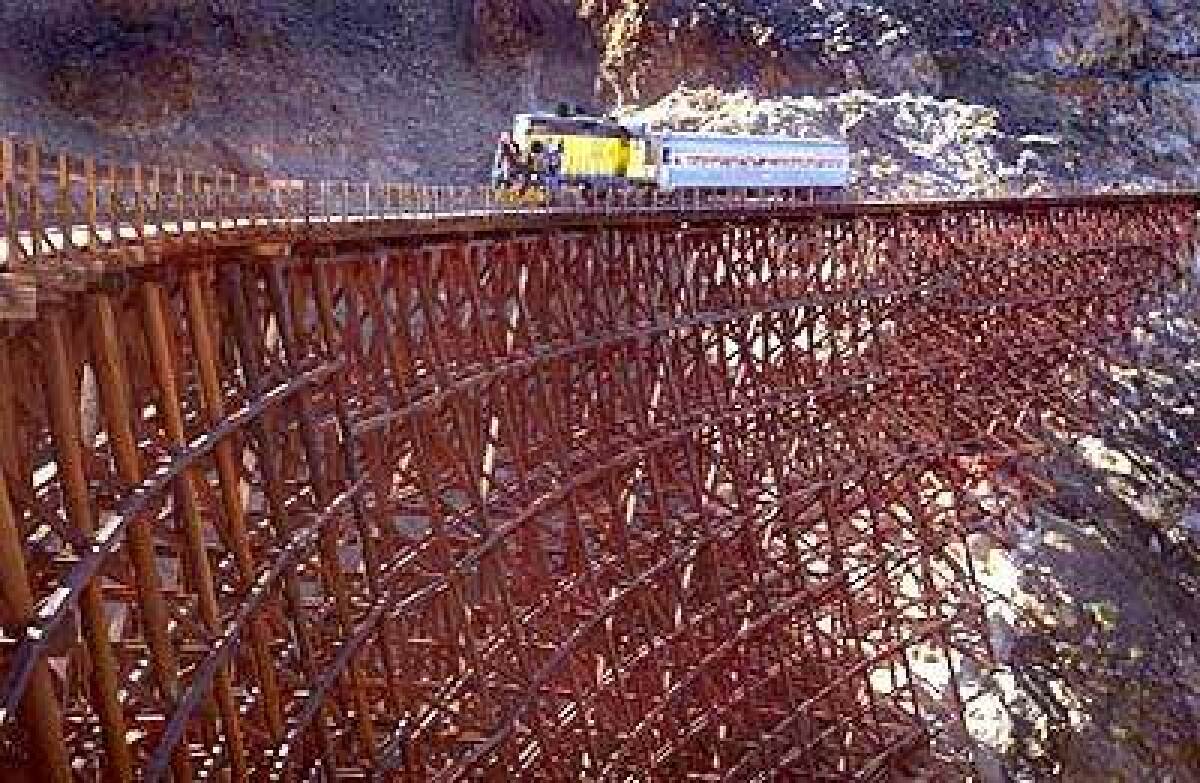Rail renegades

- Share via
The long-abandoned railroad through Carrizo Gorge in Anza-Borrego Desert State Park attracts every sort of jury-rigged contraption, from bikes modified to ride rails to dune buggies and VW chassis tricked out to run on tracks — even a rail-equipped bed frame powered by lawnmower motor.
But the free-for-all in the gorge might be coming to an end. The line’s operators, Carrizo Gorge Railway, plan to resume running freight next month.
Mountain bikers and hikers who frequent the gorge are hoping for a last-minute reprieve. “It’s a shame to see the end of this particular adventure,” says Caltech engineering professor and mountain biker Chris Brennen. “The gorge is part of our history. It illustrates a time when railroads were opening up the West and seat-of-the-pants engineers were building these great wooden trestles.”
Completed in 1919 by San Diego businessman John D. Spreckels, the Carrizo line connected San Diego with the Imperial Valley by way of a dip into Mexico and a scenic traverse of the gorge, 12 miles west of Ocotillo. The line has routinely succumbed to floods, earthquakes, collapsed tunnels, fires, rock slides, broken trestles and financial ruin. Closed to passenger service in 1951 and freight in 1982, the route earned the honorific “The Impossible Railroad.”
With its 17 tunnels and 14 major trestles, the run has since become a de facto open-air railway museum for hikers, bikers and outlaw rail-riders. Visitors follow their headlamps through a water-logged half-mile tunnel and take trail mix breaks atop abandoned boxcars. The highlight of the tour is a trek across the Goat Canyon Trestle. Spanning 630 feet and rising 186, it is one of the most massive wooden trestles in North America. A few bold souls have even rappelled from the catwalks.
If all this sounds too good to be legal, it is. Adventurers in the gorge risk federal trespass charges, but attempts to issue tickets have met varying success, never very great, says Richard Borstadt, spokesman for the Carrizo Gorge Railway.
“Hiking there has always been illegal, but it’s always been overlooked,” adds Reena Deutsch, a UC San Diego professor who gives talks on the history of the railway. “Everybody wants to go there. People are fascinated by John Spreckels and the ‘Impossible Railroad’ mystique.”
Last month the Carrizo Gorge Railway cleared the final collapsed tunnel, and for the first time in decades railroad police are trolling for trespassers. The railroad cops don’t have authority to ticket bikers and are issuing warnings for now, says Borstadt.
Mountain biker Bill Porter of Oceanside and his biker buddies not-so-secretly hope the line might not remain open for long, if it opens in the first place. “I guess they’ve been trying to reopen this track for the last 15 years or so,” he says.
Although Brennen supports the right of the railway to do business, he wouldn’t object if the gorge was returned to the people courtesy of the natural disasters that have always plagued the line. “It’s an unequal struggle between man and nature out there,” he says. “As an engineer, I wouldn’t be at all surprised if the line was closed again by earthquakes.”
Borstadt says the railway company understands the huge appeal of the Impossible Railroad, and may allow bikers and hikers access on days when there is no freight.
Whatever the company decides, there’s still another force of nature that may help the renegade riders: a herd of endangered bighorn sheep that lives in the gorge.
The San Diego office of the Center for Biological Diversity has given notice of intent to sue the Carrizo Gorge Railway and San Diego’s Metropolitan Transit System, which owns all but the Mexican portion of the line, under the Endangered Species Act.
Railroad supporters believe sheep and trains can coexist. “There is a long history of the railroad and a long history of bighorn sheep in the same vicinity,” says Jack Limber, general counsel for the San Diego Assn. of Governments, which oversees parts of the city’s Metropolitan Transit System.
For now, hikers, bikers and outlaws riding bed frames should stay off the tracks. You don’t want to find out the hard way that you can’t hear a locomotive as it’s coming straight at you.
More to Read
Sign up for The Wild
We’ll help you find the best places to hike, bike and run, as well as the perfect silent spots for meditation and yoga.
You may occasionally receive promotional content from the Los Angeles Times.






